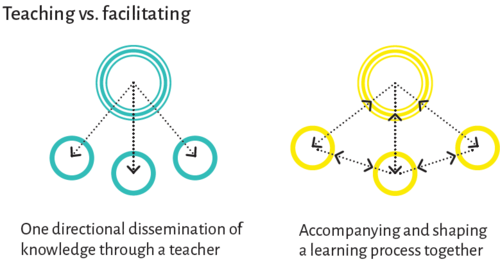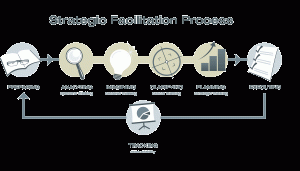
Table of Contents
What is Teaching?
- Teaching is an intensive process of sharing knowledge with an aim of increasing psychological and intellectual growth of an individual.
- Teaching is the course of attending to people’s prerequisites, skills, and emotional state, and intervening so that they learn specific things, and go further than the given.
- A procedure whereby a teacher leads a group of students in attaining new abilities, acquaintance, or thoughtful.
- Furthermost, subject area teaching implicates leading and coaching the students.
What is Facilitation?
- Facilitation is the act of engaging participants in creating, discovering, and applying learning insights.
- The art of facilitation is an essential and progressing skill, and a vital constituent of every professional’s occupational expertise.
- Facilitation skills are vital in the present day for all specialists dealing with any generous of work set, containing supervision, boards of directors, top guidance, task forces, agencies, and project groups.
Differences Between Teaching And Facilitation:
Teaching |
Facilitation |
| In teaching, teacher setting determinations to make the student acquire and recognize what is being taught. | In facilitation, student sets the concentrated efforts to self-learn and the teacher merely simplifies when the student is trapped in the learning struggles. |
| Teaching is actually teacher-centered. | Facilitating is very student-centered and is dedicated to learning. |
| Teaching is more like ‘sage on the stage’ where the teacher usually delivers the content to the audience and is more focused on his content than that of the participants. | Facilitation is more like ‘guide on the side’ who moderates the discussion, asks questions, encourages participation and engage participants in different activities |
| In teaching, teacher is a subject matter and delivery expert | In facilitation, facilitator is a learning process expert |
| It concentrates on individual conduct. | It concentrates on group dynamics. |
| Teaching mainly focuses on self-learning via self-inspection and guided set of rules. | Facilitation assists students to learn together in a group, or to accomplish to some degree together as a group. |
| In teaching, teacher is the primary controller of the session. | In facilitation, learners and facilitators coordinate the session. |
| In teaching, way of learning is decided by the teacher. | It helps the learners to determine their own way of learning. |
| It basically involves reading, listening and remembering. | It basically involves recognizing and reflecting the content |
| The teacher is accountable for determining how much information the student learns. | The facilitator helps to estimate what group members learned from their undertakings. |
| Teaching covers a wide range of delivery methods, nonetheless the one and only that individuals most instantaneously associate with the term is a lecture style. | Facilitating is a substitute delivery method in which a facilitator circles the learning prospect and aids students/participants to direct it. |
| It prioritizes on concepts/theories. | It prioritizes on the experiences and then connects experiences to theories. |
| One-way interaction (in most of the cases) in teaching means there is less probability of all the members’ interactions and skill development. | Two-way interaction in facilitation offers everyone in the group the chance to express their concepts and to feel like a major part of the team, serving their best to the team. |
| It is more appropriate for children (pedagogy). To know the differences on andragogy and pedagogy, please refer to: https://publichealthnotes.com/12-amazing-differences-between-andragogy-and-pedagogy-approach/ | It is more appropriate for adults (andragogy). To know the differences on andragogy and pedagogy, please refer to: https://publichealthnotes.com/12-amazing-differences-between-andragogy-and-pedagogy-approach/ |
| Here, participants turn out to be obedient students, clientele, and employees. | Here, participants take responsibility for their lives; grow into encouraged, self-directed, self-aware, and allied with the teams. |
| Usually, topics are recommended by the teacher. | Inspires investigators to follow thought-provoking and appropriate topics. |
| Teaching helps to add new knowledge. | Facilitation helps to connect new knowledge with experiences |
| Teaching is strategic and systematized, guided by instructions. | The goal of facilitation is to hold onto the group enthusiastically tangled in the group discussion. |
| Teaching is more acceptable into the art, music, and literature and its schemes. | Facilitation is a vital effort to build a community and world that is suitable in participants global views and perception. |
| Teaching provokes students and hold them responsible for being on exact timetable, routine, and bring to end work. | Facilitation sets an accountability system at every place so that each person is answerable to the team and for themselves (shared accountability) |
Effective Skills for Excellent Teaching:
- Be a good listener.
- Avoid hesitation to delegate and empower.
- Be conscious of requirements and recognize the need
- Be innovative
- Reveal and evaluate own performance.
- Be flexible and motivating
- Be resourceful and advanced on current modern techniques of learning
- Use diverse practices of teaching
- Avoid the tendency of thinking you are an expert
- Express friendliness and fondness towards students.
- Avoid repetition of various subject topics.
- Offer assistance that lead to student effective learning.
- Surprise students with recreational activities and field trips for refreshment.
- Respect students and their efforts. Motivate and praise students, as each one is different and extraordinary.
- Avoid criticism and negativity that hamper student perception on the teacher.
- Listen enthusiastically and carefully to students’ views.
Effective Skills for Excellent Facilitation:
Facilitators can belong from any circumstantial and a range of experience levels. The finest facilitator should possess following qualities:
- Listening—a facilitator must pay attention actively and listen to what every team member is saying.
- Questioning—a facilitator should be experienced in examining questions. Good questions are open-ended and inspires discussion.

- Problem-solving—a facilitator should be accomplished at relating group problem-solving procedures, containing:
- Describing the problem
- Defining the cause
- Allowing for a range of resolutions
- Deliberating benefits and drawbacks of clarifications
- Pick out the top solution
- Executing the solution
- Estimating the results.
- Resolving conflict
- Using a participatory style—a facilitator should be able to boost all team members to enthusiastically involve and contribute in assemblies.
- Accommodating others—a facilitator should continue an open mind and not disapprove the concepts and recommendations of group members.
- Empathetic—a facilitator should have the ability to “walk a mile in another’s shoes” to cognize the team members’ state of mind.
- Leading—a facilitator essential be able to hold onto participants dedicated and the discussion on the mark.
References and For More Information:
https://www.td.org/talent-development-glossary-terms/what-is-facilitation
http://infed.org/mobi/what-is-teaching/
https://tccl.arcc.albany.edu/knilt/images/e/ea/Cooperative_Learning_ppt.pdf
https://work.chron.com/difference-between-facilitators-teachers-11510.html
http://tools.sparkpolicy.com/wp-content/uploads/2015/04/Facilitation-vs-Teaching.pdf
https://www.extension.iastate.edu/hr/what-facilitation
https://www.td.org/talent-development-glossary-terms/what-is-facilitation
https://www.ica-uk.org.uk/what-we-mean-by-facilitation/
https://www.igi-global.com/dictionary/broadcasting-transforming-social-construction-knowledge/29344